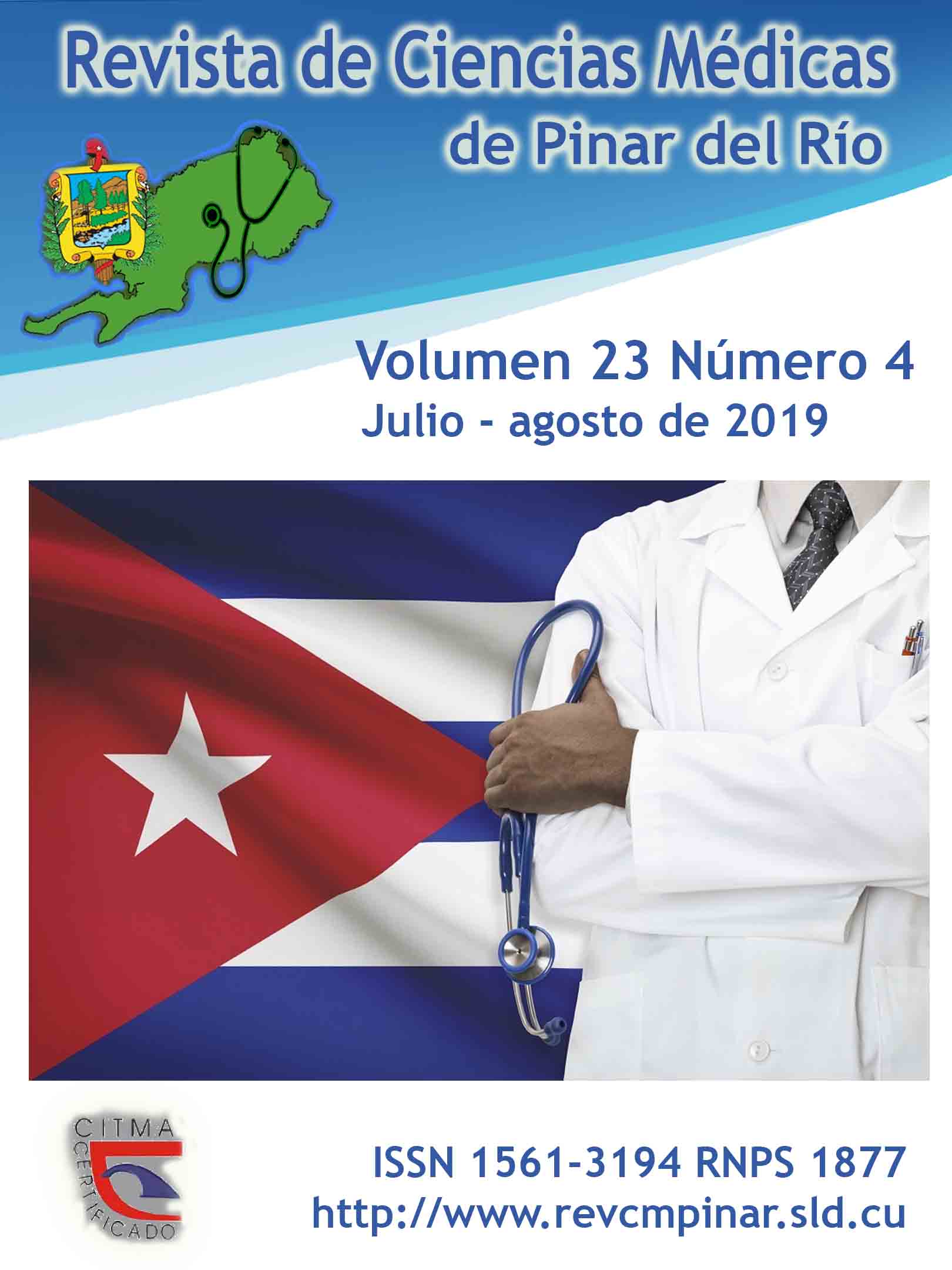Oral health and gestational diabetes at Provincial Diabetes Care Center
Keywords:
PREGNANCY, DIABETES, GESTATIONAL, ORAL HEALTH, GINGIVITIS, PERIODONTITIS.Abstract
Introduction: gestation increases the susceptibility to periodontal problems associated with levels of female sex hormones that favor inflammation. Pregnant women present xerostomia due to polyuria and affect the basal membrane of the salivary gland cells, which aggravate the bacterial growth and the decrease of the defensive properties of the saliva and the periodontium.
Objective: to describe oral health problems in pregnant women with gestational diabetes attended in the outpatient clinic of the Provincial Center for Diabetic Care.
Methods: retrospective, cross-sectional study, in the outpatient clinic from January 2017 to December 2018, made up of a total of 114 pregnant women. They underwent an oral examination, with diagnosis, orientation and referral to the second level of medical and periodontal care.
Results: differences were found according to skin color: 33.5% of white patients were under 25 years old and had an incidence of 58.6% with gingivitis and 55.1% with periodontitis, 44.4% were black and older than 25 years old; 33.3% had gingivitis and 58.3% periodontitis. In decreasing order: caries, gingivitis, edentulism, gingival retraction and xerostomy.
Conclusions: periodontal therapy is a need for treatment protocols before the 25th week of gestation and a means to improve the oral and systemic health of pregnant women. To evaluate periodontal affections as a problem associated with oral factors and systemic risks typical of the metabolic endocrine phenomenon and pregnancy physiology.
Downloads
References
1. American Diabetes Association. Standards of Medical Care in Diabetes—2016 Abridged for Primary Care Providers. Clin. Diabetes [Internet]. 2016 [citado 23/11/2017]; 34(1): [aprox. 18p.]. Disponible en: https://www.ncbi.nlm.nih.gov/pmc/articles/PMC4714725/
2. Casas Lay Y, Sánchez Salcedo M, Alvarez Rodríguez JM. Algunas variables epidemiológicas en pacientes con diabetes mellitus gestacional. Rev Cubana Obstet Ginecol [Internet]. 2014 Mar [citado: 23/04/2018]; 40(1): [aprox. 10p.]. Disponible en: http://scieloprueba.sld.cu/scielo.php?script=sci_arttext&pid=S0138-600X2014000100002&lng=es
3. Corona Miranda B, Pérez Jiménez D, Espinosa Díaz R, Álvarez Toste M, Salvador Álvarez S, Fernández González L. Caracterización de los procesos de atención prenatal a las gestantes con morbilidad materna extremadamente grave. Rev Cubana Hig Epidemiol [Internet]. 2015 [citado: 23/11/2017]; 53(1): [aprox. 8p.]. Disponible en: http://www.revepidemiologia.sld.cu/index.php/hie/article/view/2
4. Moyer VA. Screening for gestational diabetes mellitus: U.S. Preventive Services Task Force recommendation statement. Ann Intern Med. [internet]. 2014 [citado: 23/11/2017]; 160(6): [aprox. 12p.]. Disponible en: https://annals.org/aim/fullarticle/1813285
5. Metzger BE. Diabetes mellitus and pregnancy. In: Jameson, J.L. and De Groot, L.J. Endocrinology: Adult and Pediatric. Chap 45. 7th ed. Philadelphia, PA: Elsevier Saunders; 2016.
6. Papone V, Verolo C, Zaffaroni L, Batlle A, Capó C, Bueno L, et al. Detección y prevalencia de patógenos periodontales de una población con periodontitis crónica en Uruguay mediante metodología convencional y metagenómica. Odontoestomatología [Internet]. 2015 mayo [citado: 05/01/2019]; 17(25): [aprox. 9p.]. Disponible en: http://www.scielo.edu.uy/scielo.php?script=sci_arttext&pid=S1688-93392015000100004&lng=es
7. Fajardo Puig ME, Rodríguez Reyes O, Rodríguez Bacallao A. Las hormonas sexuales femeninas y su relación con la enfermedad periodontal. MEDISAN [Internet]. 2017 [citado: 05/01/2019]; 21(1): [aprox. 4p.]. Disponible en: http://scielo.sld.cu/scielo.php?script=sci_arttext&pid=S1029-30192017000100013&lng=es
8. Rodríguez MJ, Mejía LP, Peñaloza EY, Urueña J. Conocimientos de los médicos sobre enfermedad periodontal y su relación con complicaciones en el embarazo. REVISTA SALUD UIS [Internet]. 2013 [citado: 05/01/2019]; 45(3): [aprox. 4p.]. Disponible en: http://revistas.uis.edu.co/index.php/revistasaluduis/article/view/3891/5322
9. Díaz Valdés L, Valle Lizama L. Influencia de la salud bucal durante el embarazo en la salud del futuro bebé. Gac Méd Espirit [Internet]. 2015 [citado: 05/01/2019]; 17(1): [aprox. 4p.]. Disponible en: http://scielo.sld.cu/scielo.php?pid=S1608-89212015000100012&script=sci_arttext
10. Alvarez Silvares E, Domínguez Vigo P, Alvarez Pérez MT, Domínguez Sánchez L, Gonzales González A. Factores Bioquímicos de riesgo de diabetes mellitus en mujeres con diabetes gestational previa. Ginecología obstetrician México. [Internet]. 2016 julio [citado: 05/01/2019]; 84(7): [aprox. 11p.]. Disponible en: https://www.medigraphic.com/pdfs/ginobsmex/gom-2016/gom167e.pdf
11. Rivas A, Rivero C, Salas M, Urbina G, Vellanueva J. Enfermedad periodontal en mujeres embarazadas. Artículo de revisión. Rev. Venezuela Invest. Odont. [Internet]. 2014 [citado: 05/01/2019]; 2(1): [aprox. 15p.]. Disponible en: http://erevistas.saber.ula.ve/index.php/rvio/article/view/4843
12. Madura Larsen J. The immune response to Prevotella bacteria inchronic inflamatory disease. Immunology. [Internet]. 2017 August [citado: 05/01/2019]; 151(4): [aprox. 10p.]. Disponible en: https://www.ncbi.nlm.nih.gov/pmc/articles/PMC5506432
13. Sierra Virrueta MA. Ph y flujo salival en gestantes, durante el primer trimestre de embarazo, atendidas en el consultorio externo de Ginecobstetricia del hospital III Yanahuara. ESSALUD. Arequipa-2016. [Tesis]. Arequipa: Universidad Alas Peruanas. Facultad de Medicina Humana y Ciencias de la Salud. Escuela Profesional de Estomatología; 2017 [citado: 05/02/2019]; [aprox. 111p.]. Disponible en: http://repositorio.uap.edu.pe/handle/uap/5225
14. Zerón A. Concenso. 9o Taller Europeo-Enfermedades periodontales y Enfermedades sistémicas. Revista de la Asociación Dental Mexicana [Internet]. 2013 [citado: 05/01/2019]; 70(4): [aprox. 10p.]. Disponible en: www.medigraphic.com/pdfs/adm/od-2013/od134j.pdf
Published
How to Cite
Issue
Section
License
Authors who have publications with this journal agree to the following terms: Authors will retain their copyrights and grant the journal the right of first publication of their work, which will be publication of their work, which will be simultaneously subject to the Creative Commons Attribution License (CC-BY-NC 4.0) that allows third parties to share the work as long as its author and first publication in this journal are indicated.
Authors may adopt other non-exclusive license agreements for distribution of the published version of the work (e.g.: deposit it in an institutional telematic archive or publish it in a volume). Likewise, and according to the recommendations of the Medical Sciences Editorial (ECIMED), authors must declare in each article their contribution according to the CRediT taxonomy (contributor roles). This taxonomy includes 14 roles, which can be used to represent the tasks typically performed by contributors in scientific academic production. It should be consulted in monograph) whenever initial publication in this journal is indicated. Authors are allowed and encouraged to disseminate their work through the Internet (e.g., in institutional telematic archives or on their web page) before and during the submission process, which may produce interesting exchanges and increase citations of the published work. (See The effect of open access). https://casrai.org/credit/



